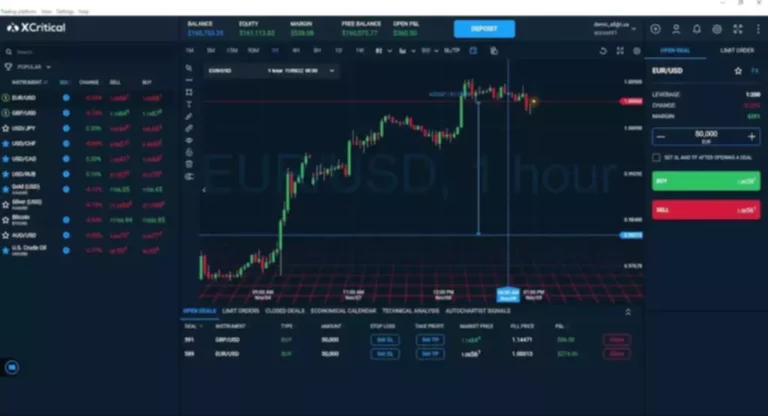What is Decentralized Finance DeFi? CI Global Asset Management
Content
Aave (AAVE) competes with Maker as the largest lending platform by TVL. As of today, it has over $11 billion worth of crypto as collateral. As cryptocurrency has continued to grow in popularity, so too has the need for strong tools that can effectively track market data, monitor portfolios, and keep individuals abreast of trends. Make sure to check out the De.Fi SuperApp, whether you are looking to guard against crypto scams, make a quick trade, or check out the best possible opportunities for you to deploy your funds. In addition to being an Automated Market Maker (AMM) DEX like Uniswap, PancakeSwap also features perpetual swap markets, allowing you to trade with leverage, and potentially amplifying your gains. Since its launch on the BNB chain, it how to invest in defi has since expanded to new ecosystems like Arbitrum, Ethereum, Base, ZkSync, Linea zkEVM, and others.
Best Derivative Trading Platform

Specifically, DeFi has the potential to make loans, insurance, international payments and much more accessible to anyone with an Decentralized finance internet connection. This means people can take control of their own economy, and do not need to rely on a bank or other financial middlemen. The financial market handles billions of dollars every hour, and is currently using ineffective legacy technologies. Blockchain technology and DeFi has the potential to drastically improve everything from the remittance market to loans and insurance. Put simply, DeFi can be seen as being the financial ecosystem emerging from blockchain technology.
What is Crypto Gambling? Full Guide to Online Crypto Gambling

If you have been in the DeFi space since its https://www.xcritical.com/ early days, Uniswap should be no stranger to you. Uniswap is a leading decentralized exchange (DEX) that facilitates the swapping of various cryptocurrencies without the need for a central intermediary. It operates on an automated liquidity protocol, meaning that liquidity is provided by users who deposit their funds into pools. Liquidity mining is the process of depositing crypto assets in a liquidity pool.
Trade UsingReal-time andOn-chain Data!
It should also allow easy interaction with different DeFi platforms. Users should ensure their wallet can store various DeFi tokens and is compatible with major protocols like Uniswap or Aave. Managing private keys is also crucial, as it ensures that only you have access to your funds.
A. Understanding Decentralized Finance Projects
Investors enjoy the benefit of flexibility because analysis and research that they would have to undertake themselves can now be outsourced. The proof of history concept of Solana is of particular note, which is helping revolutionize consensus mechanisms. Users no longer need to mine or stake on the platform to validate transactions, because all of them are proven true by a time stamp on the blockchain. Solana is a Layer 1 platform just like Ethereum, and does not need another platform’s support for transactions.
Cryptocurrencies like ETH (Ethereum) are often required to interact with DeFi protocols, as they are used to pay transaction fees (gas fees) and to invest in various financial products. Investors can buy cryptocurrencies on centralized or decentralized exchange platforms. It is important to choose a reputable exchange platform for its reliability and security.
That secures the system by providing users with anonymity, plus verification of payments and a record of asset ownership that’s (nearly) impossible to alter by fraudulent activity. Instead, it prides itself on being run by its own members, and all member decisions are kept on-the-record with smart contracts and the Ethereum public blockchain. Besides just representing the ultimate – and ambitious – end goal of DeFi, in giving universal access to financial markets, UMA is also a protocol. Oasis is another DeFi platform, or dApp, which acts as a liquidity pool. The platform, sometimes known as ”oasis.app”, is built on a secure Ethereum protocol, and takes significant inspiration from MakerDAO and the DAI stablecoin.
The most likely future will involve some form of hybrid finances, in which some DeFi services merge with traditional finance. Already, solutions have launched to allow users to place some of their retirement investments into digital currencies and have some of their savings accounts in crypto, according to Wang. In addition, DeFi doesn’t offer the same security a financial institution can.
It is unregulated, and its ecosystem is vulnerable to faulty programming, hacks, and scams. For example, one of the main ways hackers and thieves steal cryptocurrency is through weaknesses in DeFi applications. A crypto-winter is a period where crypto prices continuously move down and then stay down—sometimes tens of thousands of dollars. Prices had been rising significantly before 2022 as investors turned to anything they could find following the initial outbreak of COVID-19 and the ensuing pandemic. Transactions do not include an individual’s name but are traceable by anyone with the knowledge to do so.
- It is natural for incentives to fluctuate repeatedly, which means yield farmers frequently move their funds from platform to platform, farming higher ‘yields’.
- One of Aave’s notable features is the introduction of ‘flash loans’ – these are massive loans that do not require collateral but must be borrowed and repaid within the same blockchain transaction.
- Although some would argue the ”true” notion of stablecoins consists of decentralized stablecoins, others disagree.
- This is fairly technical, but the UMA Whitepaper goes into greater detail on it.
- Blockchain is a kind of ledger technology that tracks all transactions on a given financial platform.
- A popular Ethereum-based wallet, MetaMask is known for its ease of use and integration with most DeFi platforms.
- Along with diversification, effective risk management is necessary.
MetaMask is a cryptocurrency wallet where users can store Ethereum and other Ethereum-based tokens, with Ethereum being the main network used in decentralized finance. Ethereum, an open-source blockchain platform and the second most popular cryptocurrency, took it a step further, providing the infrastructure for programmable smart contracts. Because of this, most decentralized apps today are built using Ethereum’s software. Because it utilizes the blockchain, individuals and businesses can transact other asset types that aren’t accessible through traditional financial means, such as smart contracts and non-fungible tokens. To start investing in DeFi, the first step is to prepare a wallet of your own. It is recommended to pick only from the best wallets that provide access to exchanges for trading DeFi coins and DeFi protocols for participating.
The DeFi insurer Nexus Mutual is, therefore, shaking up things that have been in place since the traditional insurance model first came about in the 17th century. As such, MakerDAO, the DAI stablecoin, the MKR token and CDPs are sure to stay an important part of the emerging DeFi field. Additionally, Tether has been issued on several different blockchains. Specifically, there is Tether on the Omni, Tron, EOS, Liquid, Algorand and Ethereum blockchains.

Developers write smart contracts to perform specific actions only when certain conditions are met. Thousands of cryptocurrency projects have expanded into the DeFi space, so it can be hard to distinguish between long-term DeFi platforms and cash grabs. As a general rule of thumb, if a token offers high returns for doing nothing (often referred to as frictionless yield farming) it’s likely a pyramid scheme with no long-term potential. Decentralized finance (DeFi) is a relatively new phenomenon that was made possible by Ethereum’s network, or more specifically smart contracts. The main functions that DeFi serves today are in the lending and trading sectors, but the industry is quickly growing.
Unlike centralized exchange platforms like Binance, DEXs don’t operate order books. Instead, they act as automated market makers (AMMs), hosting liquidity pools to trade against. A leading hardware wallet, Ledger offers robust security by storing private keys offline.
That all changed during what Wang called the “Summer of DeFi” in 2020. Suddenly, DeFi smart contracts went from $700 million to $15 billion, according to cryptocurrency news website Decrypt. USDC (USDC 0.0%) is another stablecoin, but, unlike DAI, its collateral is centralized. USDC stablecoins are backed by a reserve of U.S. dollars held in an audited bank account.
Decentralized finance apps require no such things and don’t have the power to touch your funds. Cryptocurrency previously had to be purchased from digital exchanges that relied on clunky background checks. When those companies got hacked, people’s accounts got exposed, causing them to lose money. Still, the potential to revolutionize existing financial practices remained largely theoretical as the technology developed, said James Wang, head of tokens for Amun, a DeFi index firm. The newness of DeFi technology means that negative outcomes can unexpectedly occur.


